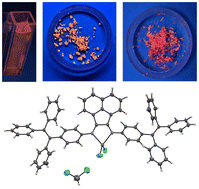Aggregation-induced emission of a bis(imino)acenaphthene zinc complex with tetraphenylethene units†
Abstract
Using bis(imino)acenaphthene (BIAN) zinc(II) and palladium(II) complexes with tetraphenylethene (TPE) units as bulky aryl groups, Zn-2 and Pd-2 have been designed and developed, and their photophysical properties in solution and in the solid state have been investigated. Both in solution and in the solid state Zn-2 and Pd-2 show two photoabsorption bands in the ranges of 300 nm to 350 nm and 450 nm to 600 nm, which are assigned to the π–π* transition originating from both the TPE units and naphthalene units and the intraligand charge transfer (ILCT) between the TPE units and the BIAN unit, respectively. Density functional theory (DFT) calculations demonstrated that for Zn-2 the highest occupied molecular orbitals (HOMO) are localized on the TPE units, while the lowest unoccupied molecular orbitals (LUMO) are localized on the BIAN unit, leading to the appearance of a photoabsorption band on the ILCT. The emission from Zn-2 was quenched in solution, but appeared as phosphorescence at around 600 nm by photoexcitation at the ILCT band in the solid state as well as in the aggregated state, which was formed by the addition of n-hexane as a poor solvent to the dichloromethane (DCM) solution. The aggregate formation of Zn-2 in the DCM/n-hexane (10 wt%/90 wt%) solution was confirmed by the Tyndall scattering and scanning electron microscopy (SEM) measurements, demonstrating the aggregation-induced emission (AIE) characteristics of Zn-2. On the other hand, Pd-2 was non-emissive in the solid state and in the aggregated state as well as in solution. Moreover, the DCM-inclusion complexes of Zn-2 and Pd-2 were obtained and their photophysical properties were investigated. It was found that the photoluminescence quantum yield (ΦPL-solid) values of Zn-2 and Zn-2-DCM in the solid state are less than 1%. Single-crystal X-ray structural analysis of Zn-2-DCM revealed the absence of intermolecular π–π interactions. Consequently, it was suggested that the low ΦPL-solid value of Zn-2 is mainly due to the radiationless relaxation of the excitons by dynamic rotation of the phenyl groups of the TPE units, even in the solid state and in the aggregation state.

- This article is part of the themed collection: Spotlight Collection: Aggregation induced luminescence of metal complexes


 Please wait while we load your content...
Please wait while we load your content...